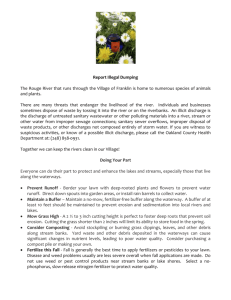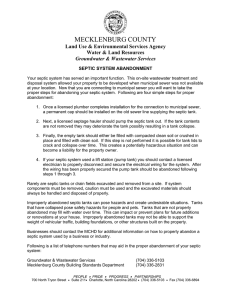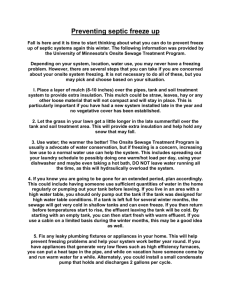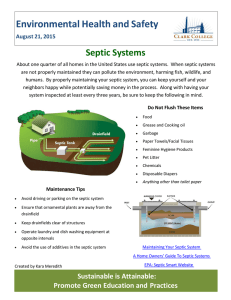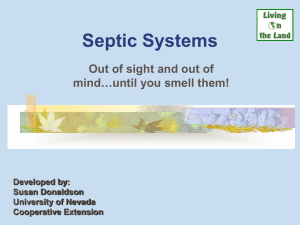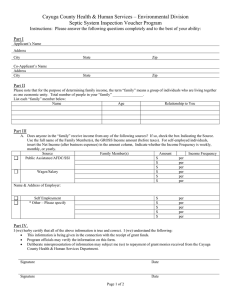Maintaining Your Septic System
advertisement
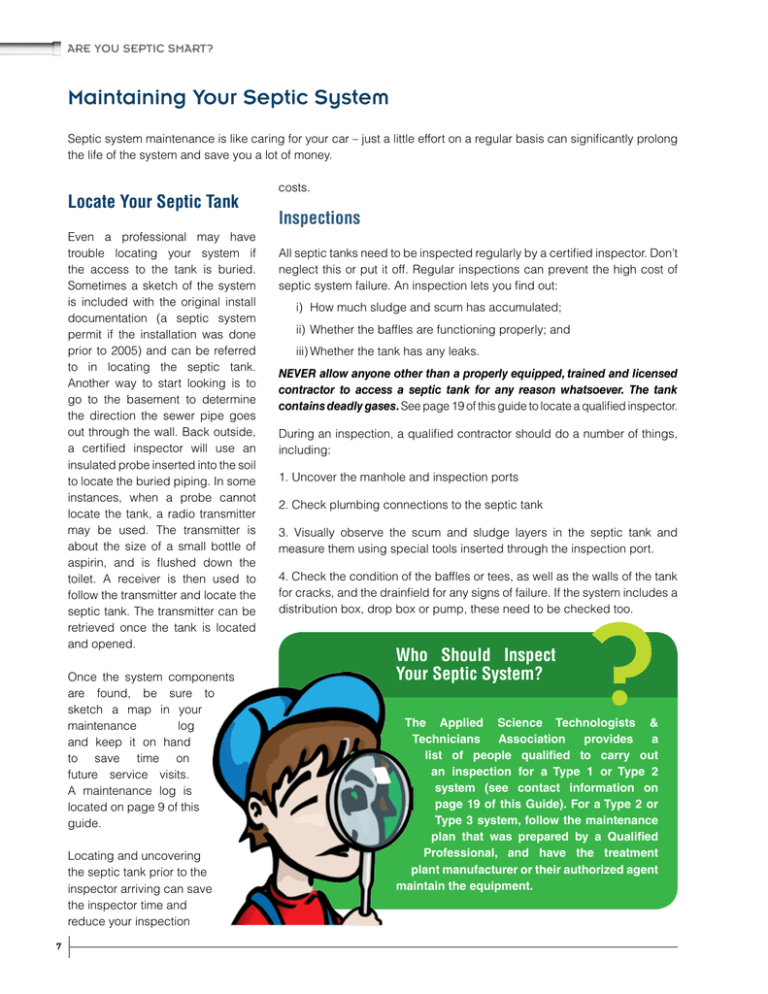
ARE YOU SEPTIC SMART? Maintaining Your Septic System Septic system maintenance is like caring for your car – just a little effort on a regular basis can significantly prolong the life of the system and save you a lot of money. Locate Your Septic Tank Even a professional may have trouble locating your system if the access to the tank is buried. Sometimes a sketch of the system is included with the original install documentation (a septic system permit if the installation was done prior to 2005) and can be referred to in locating the septic tank. Another way to start looking is to go to the basement to determine the direction the sewer pipe goes out through the wall. Back outside, a certified inspector will use an insulated probe inserted into the soil to locate the buried piping. In some instances, when a probe cannot locate the tank, a radio transmitter may be used. The transmitter is about the size of a small bottle of aspirin, and is flushed down the toilet. A receiver is then used to follow the transmitter and locate the septic tank. The transmitter can be retrieved once the tank is located and opened. Once the system components are found, be sure to sketch a map in your maintenance log and keep it on hand to save time on future service visits. A maintenance log is located on page 9 of this guide. Locating and uncovering the septic tank prior to the inspector arriving can save the inspector time and reduce your inspection 7 costs. Inspections All septic tanks need to be inspected regularly by a certified inspector. Don’t neglect this or put it off. Regular inspections can prevent the high cost of septic system failure. An inspection lets you find out: i) How much sludge and scum has accumulated; ii) Whether the baffles are functioning properly; and iii)Whether the tank has any leaks. NEVER allow anyone other than a properly equipped, trained and licensed contractor to access a septic tank for any reason whatsoever. The tank contains deadly gases. See page 19 of this guide to locate a qualified inspector. During an inspection, a qualified contractor should do a number of things, including: 1. Uncover the manhole and inspection ports 2. Check plumbing connections to the septic tank 3. Visually observe the scum and sludge layers in the septic tank and measure them using special tools inserted through the inspection port. 4. Check the condition of the baffles or tees, as well as the walls of the tank for cracks, and the drainfield for any signs of failure. If the system includes a distribution box, drop box or pump, these need to be checked too. Who Should Inspect Your Septic System? The Applied Science Technologists & Technicians Association provides a list of people qualified to carry out an inspection for a Type 1 or Type 2 system (see contact information on page 19 of this Guide). For a Type 2 or Type 3 system, follow the maintenance plan that was prepared by a Qualified Professional, and have the treatment plant manufacturer or their authorized agent maintain the equipment. CSRD’s ONSITE SEPTIC SYSTEM HOMEOWNERS GUIDE Pump Outs System Additives It is important to have your septic system pumped out by a licensed septic system contractor on a regular basis. A licenced contractor will have the appropriate equipment and will dispose of the sludge at an approved treatment site. The bacteria needed by a septic system occur naturally. It is a ‘rural’ myth that biological additives such as yeast or meat need to be added to your system. No commercial starters, bacterial feeds or cleaners are required or recommended. How often you should pump out your septic tank depends on the tank size, the number of people living in your home, and the habits of your particular household. Garburators and food preparation practices also affect the pumping frequency. Discuss this with your pumping contractor during the first inspection. There are two types of septic system additives that you may find marketed on the internet: biological (like bacteria, enzymes, and yeast) and chemical. While many products on the market claim to help septic systems work better, the truth is there is no magic potion to cure an ailing system. The biological additives may be harmless but some chemical additives can potentially harm the soil in the drainfield and contaminate the groundwater. Some additives can kill off the healthy bacteria in your tank and are not recommended. Pumping Tips • Be present when your tank is being pumped. Make sure that the contractor uses the manhole, not the inspection ports, to pump the tank to avoid damaging the baffles or tees. Also make sure all the material in the tank is removed. It is not necessary to leave anything in the tank to “restart” the biological processes, but it is also not necessary to scrub or disinfect the tank. • It’s best to pump in the summer or fall, before cold weather. No commercial starters, bacterial feeds or cleaners are required or recommended Septic Heaven Septic systems do not last forever. If you find that your onsite septic system is no longer functioning, you may need to consider an alternative -- or part or all of it may have to be dug up and replaced. A ROWP should be contacted to provide assistance in assessing your onsite system problems and developing an appropriate solution to your circumstances. If your circumstances are particularly difficult, they may refer you to a Qualified Professional for further assistance. 8 ARE YOU SEPTIC SMART? System Maintenance for Type 2 and Type 3 Systems Type 2 and Type 3 systems have much smaller drainfields than Type 1 systems. Instead, they rely on bacteria contained within a package treatment plant to further treat wastewater coming from a septic tank before it enters the drainfield. These package treatment systems are typically mechanical processes that have pumps, air blowers, and electrical components that can break down if they are not properly maintained. If you don’t maintain a Type 2 or Type 3 package treatment plant, it will fail to treat the wastewater adequately, resulting in the drainfield overloading, clogging and ultimately failing. The result? High repair costs and potential public health and environmental consequences. As the oil filter advertisement goes “You can pay me now … or pay me later!” It is typically far less expensive to routinely inspect, maintain, and make minor repairs to a treatment system, than to neglect it and have it break down and fail abruptly, or even worse, slowly and progressively clog your drainfield until the entire system suddenly fails at great cost and inconvenience to your family. If your property requires a Type 2 or Type 3 system, your Authorized Person will prepare a detailed maintenance program for you and will provide you with a schedule of preventative maintenance activities. Following the maintenance program is not only essential to prevent treatment problems or system failures, it is also required by law. Make yourself aware of the maintenance schedule and, ideally, contract the maintenance servicing to a company with an Authorized Person on staff who is knowledgeable in the area of onsite system maintenance and is authorized and certified by the manufacturer to maintain your package treatment plant. It is typically far less expensive to routinely inspect, maintain, and make minor repairs to a treatment system, than to neglect it and have it break down and fail abruptly. Two-compartment concrete septic tank 9 CSRD’s ONSITE SEPTIC SYSTEM HOMEOWNERS GUIDE Maintenance Records It is very important to keep a detailed record of all inspections, pump outs, permits (for installations before 2005), repairs, and any other maintenance to your system along with a sketch of where your septic system is located. Having this information on hand for service visits can save you both time and money. Tear out this maintenance chart and keep it in a safe place to track the performance of your septic system. Maintenance Record Chart Home address/location: Type of Drainfield System: Conventional Trench Shallow Trench Conventional Bed Raised Bed or Mound Contour Trench Drywell Type of Distribution System: Other (give details) Gravity Pressure System Designer Name:Phone No: Address: System Installer: Name:Phone No: Address: Local Inspector: Name:Phone No: Address: Documents: Copy of Site Evaluation SAMPLE: House Copy of Sewage System Permit, including drawings 1m Septic Tank 2m 5m Copy of Final Inspection and Use Report 6m System Map: 15m Manufacturers’ Instructions and Warranties Sketch map showing location of septic system and house on lot Results Date Inspected OK Pumped Out Repairs Needed Other Contractor Name/Initials 10

